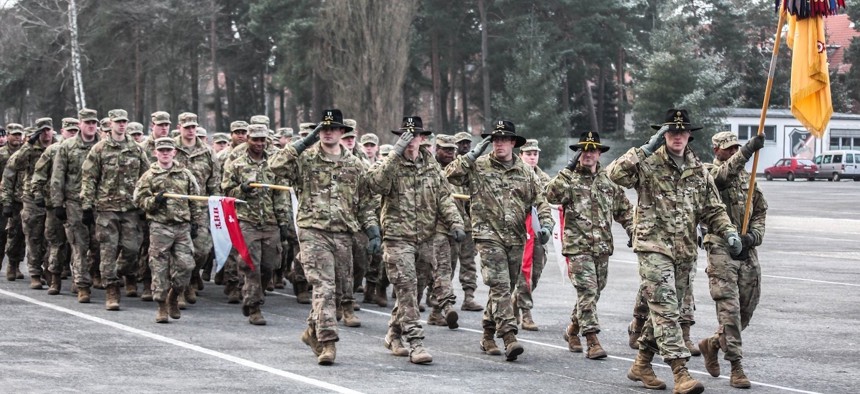
U.S. Soldiers march in formation during a ceremony hosted by the Polish 10th Armored Cavalry Brigade in Swietoszow, Poland, Jan. 22, 2018. Polish Land Forces / Pvt. Natalia Wawrzyniak
Army Retention on Track, Even as Recruiting Struggles
Even the busiest of units are seeing high retention as Army programs seek to smooth out the stress of service life.
When Tobey Whitney joined the Army at 32 after 9/11, he expected to serve just four years. But after two decades and three deployments to Iraq, Sgt. Maj. Whitney is still in uniform, part of a broader trend of soldiers choosing to stay in the Army even as the service struggles to bring in new recruits.
Whitney is far from an anomaly. The Army is on track to meet its goal of retaining 55,100 soldiers this year who are otherwise eligible to retire, according to Congressional testimony by Army Undersecretary Gabe Camarillo. The Army also met its retention goals in 2022 and 2021, Camarillo said.
Retention numbers are “historically high,” said Agnes Schaefer, assistant Army secretary for manpower & reserve affairs, at an event Tuesday hosted by the Center for a New American Security. And even parts of the service that are under high stress are seeing good retention.
Air defense forces are deployed at twice the rate of the overall Army because of threats in Europe, China, and the Middle East, Lt. Gen. Daniel Karbler, commander of U.S. Army Space and Missile Defense Command, told Congress in April. The resulting stress was eating away at soldiers’ “readiness and family well-being,” he said.
The trend is not new: in August 2020, crews for Patriot anti-air missiles batteries deployed more often than Army Special Forces.
But in 2022, the Army’s quick-deployment air defense forces, run by 32nd Army Air and Missile Defense Command, had a 109.7 percent mission retention rate, Karbler testified.
Retention stands in stark contrast to the Army’s recruiting crisis. The service’s numbers are better this year than last, Army Chief of Staff Gen. James McConville said at a D-Day commemorative event on June 5, but the service is still set to fall short of its 65,000 recruit target, Army Secretary Christine Wormuth said in May.
Whitney, now the Army’s senior career counselor, joined the 82nd Airborne in 2003 after serving 10 years as a police officer. He had long wanted to serve in the military, but deferred after having a child at 18. But September 11 pushed him into service. “I knew that I had missed my calling before, and I wasn't gonna miss it again,” he said.
Joining up at the start of the Iraq war, Whitney faced mortar fire on his first day in the country.
He stayed in the Army, despite the risks, for what it had to offer his family. His son went to college on his tuition assistance, and his healthcare costs were covered by the Army without any premiums. “My quality of life as a soldier was better than it was as a police officer,” Whitney told Defense One.
Army officials haven’t cited one single factor as contributing to high retention, but have emphasized non-monetary factors—most notably soldiers’ ability to choose where to serve.
“We try to provide soldiers with a wide variety of options,” Whitney said, calling out programs that allow soldiers to stay at a favored base longer, change their career field, or move to new locations.
Extra money is also helpful, Whitney said, but noted the Army pays less than half of soldiers a reenlistment bonus. Instead, he said, he sees many soldiers motivated by the ability to control where they’re living, either to stay where they are or go closer to family
The Army’s busy deployment schedule, which Sergeant Major of the Army Michael Grinston has called an “enormous strain” so far isn’t hurting retention, Whitney added. In fact, units that deploy more frequently have “great” retention, he said.
While he didn’t have specific data to point to, the four-times-deployed soldier pointed to the unifying effect a deployment can have, as well as the satisfaction that comes with “actually doing what you came in to do,” he said.
Nor was the Army’s recent emphasis on diversity a problem for retention, which Whitney called a “non-issue.”
The Army is also doing studies to see if economic pressures are key at keeping the soldiers in, Whitney added, amid an U.S. economy that has been buffeted by inflationary pressures.
Schaefer, the Army’s manpower chief,, flagged similar reasons for high retention rates. “Quality of life is a huge issue for us,” Schaefer said, noting benefits like child care, spousal employment, and barracks improvements.
In a nod to the importance of choosing an Army base over cash, she noted that letting people choose their station led to better staffing results than offering a bonus for moving there.
“Some people want to go to remote and isolated places,” she said, noting the popularity of Alaska among certain soldiers. “But that’s different when you're forced to go.”
The Army is also seeking new ways to boost retention. Whitney said that a study of younger service members aims to identify participants' most favored incentives for staying.
On Whitney’s initiative, the Army and other branches also meet quarterly to share best practices related to recruiting. Thanks to this work, the Army may introduce a Navy practice of having a central repository of guidance counselor advice, thus allowing guidance counselors at a soldiers’ new stations to see previous advice given to the soldier.
Schafer, meanwhile, has been pushing for even more flexibility for soldiers’ careers. “I worry that the incredibly siloed system that we have right now is outdated,” she said. “We need to move more towards a jungle gym type of a system where people can move around depending on life circumstances.”
Without retaining soldiers, she added, the Army is “just a tin can.”
Correction: An earlier version of this report misstated the percentage of soldiers who left the Army in 2021 and 2022.




